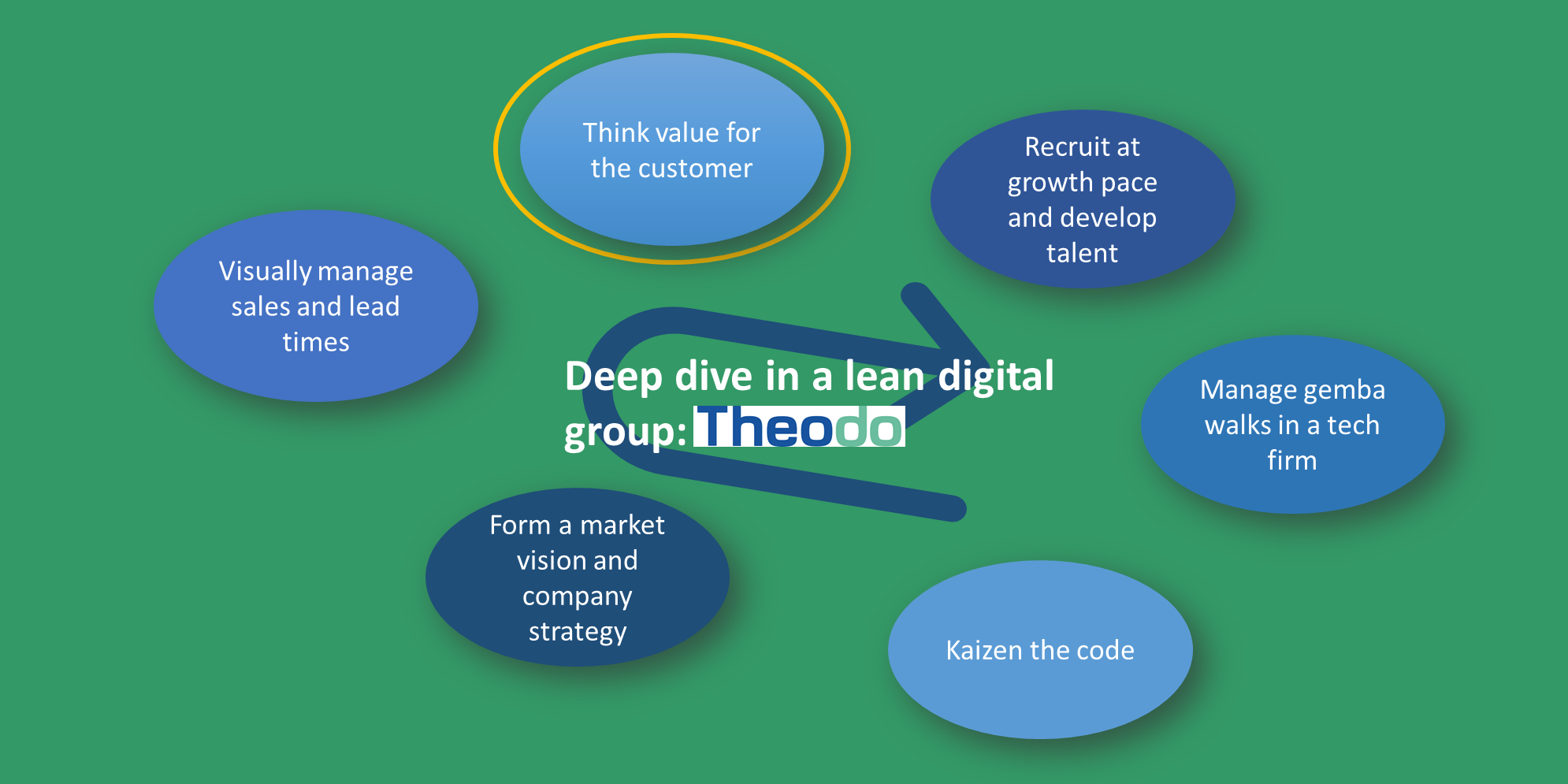
Deep dive in a lean digital company #2
FEATURE – In the second article in her new series, the author discusses how focusing on customer value helped a fintech start-up to grow fivefold just last year.
Words: Catherine Chabiron, lean author and member of Institut Lean France
You may have read my previous article on the Theodo group. It was an account of the day I spent with Caroline, COO of Theodo France, and it focused on sales and project management at the company. I then decided to go deeper in my analysis of the company, taking you readers on a complete tour of this successful lean organization operating in the digital world.
I think it is a great opportunity to explore how lean techniques and concepts originally developed in the automotive industry have progressively been transposed and merged into the DNA of the tech world. Each of the steps above will be the object of an article, from customer to people, from tech and learning to strategy.
FOCUSING ON CUSTOMER VALUE PAYS OFF
This article focuses on customer value, which is more than a buzzword for the company I am visiting today, Sipios. If the proof is in the pudding, it should suffice to say that, in 2020 alone, its turnover grew fivefold!
The Theodo Group is a galaxy of spin-offs and Sipios, a fintech created in 2017, is one of them. (If you aren’t any more familiar with the term than I was prior to my visit, know that a fintech is an innovating start-up that uses technology to offer new or redesigned banking and financial services.)
Sipios’ offices are located on the top floor of the Theodo building, near the Parisian district of Montmartre. Young start-ups need to attract both customers and talent to thrive, and I bet the view from the rooftop is a big selling point for them!
Rodolphe, co-founder and CEO of Sipios, joined Theodo in 2015 with a Legal and Finance educational background. He started Sipios two years later. “I had done a traineeship in a bank during my studies, and I knew from the very first day that it was not me. I created my own company soon after, but swiftly understood that I needed more experience and understanding of the trade. I wanted to remain in the tech world, learn from more experimented people and join a growing company. This is why I sold my start-up and joined Theodo,” he tells me.
Founding a spin-off barely two years after joining the group can easily be seen as a great success, but it wasn’t exactly a walk in the park. In fact, 2019 turned out to be a difficult year for Sipios. “Offering to deliver an app based on specifications issued by a customer is all well and good, but the problem is that many other companies can code and do the same. We needed something to help us stand out from the crowd,” Rodolphe explains.
START WITH A DEEP UNDERSTANDING OF YOUR TARGETED MARKET
How do you go about listening and understanding your target market? Rodolphe started to read the trade press and to peruse the websites of various finance- and banking-focused media outlets. Banks have been operating under tough conditions since 2008: strict rules now exist to protect their capital from undue risks, interest rates are the lowest they have ever been, and neobanks have started to hack the century-old bank-counter-with-a-clerk approach, developing a considerably improved user experience online.
Rodolphe is rather reserved but admits that reading was not enough. He had to go out and interview both existing and prospective customers. He set himself an ambitious objective to speak to 100 people. When you are a shy person and you are learning your trade through sales pitches, this can be a bit overwhelming. Yet, Rodolphe powered through, knowing how Lean Thinking teaches us that developing our own skills and genuinely listening to the stakeholders in our trade leads to huge pay-offs.
Rodolphe started to organize his thinking by writing down his understanding of the market. Those who succeed, he realized, have a deep understanding of their customers, are leaders on a highly scalable technology, and know how to attract and retain talent, so as to engage their teams on the best user experience. From a customer point of view, he learned a fundamental lesson, he tells me: “I started interviews with my usual contacts in banks, but as I developed an understanding of their common issues, market positions and challenges, they felt they needed to take me up to the C Level, to share the points I was raising and eventually discuss possible gains for the bank through technology”.
CHANGE YOUR SALES PITCH, ADJUST TO NEW STAKEHOLDERS
This shift in approach changed Sipios’ modus operandi drastically. Using a number of examples, Rodolphe shows me how the company moved from a delivery-focused stance (“give me the specs, I’ll develop”) to showing how and why they anticipate their solution will solve the customer’s problem.
Before, when answering a bid or offering their services, they mostly listed their delivery achievements, what they were good at, which technology they mastered, and included the usual reference page of well-known brands that had at least once secured their help. Now, the sales pitch is developed by means of long up-front discussions supported by an internal document called the “exec summary”, which lists what they know to be the standard pain points and risks of a sale.
Rodolphe and I have now moved over to the sales area. There, we meet with Jean-Philippe, who was recruited a year ago to cope with the new pre-sales approach and the huge increase in demand that followed its introduction.
The exec summary Jean-Philippe is working on is based on five key points: 1) Why now? 2) What gains for the customer? 3) How to achieve them? 4) Which secret sauce could we use (technology, know-how, method) to ensure we make a better job than others ? 5) What’s in the deal that they cannot refuse?
Rodolphe says that they are thinking of adding a sixth point, on customer risks. As they are getting good at understanding not the solution the customer wants, but the actual problem they are trying to solve, they sometimes unveil factual elements the customer had not seen. As the team dug further into problems ahead of the sales, they developed their ability to highlight potential customer gains – an approach that is of course very appealing to top management because it can lead to competitive advantage. On the other hand, this means that to prepare for discussions with the C-suite their executive summary has to be regularly updated with the risk information.
Below you can see before-and-after extracts of a sales offer to the same customer (the “before” offer was turned down, by the way). In a way, Sipios moved from a push (let’s sell our capabilities) to a pull approach (let’s understand the problem and demonstrate value with a prototype).

Moving from delivery (push mode) to customer gains (pull mode) had one major consequence. Sipios found they had to bridge the gap between the two by showing a mock-up of the product before the sales was closed. “This huge investment in the why and the how ahead of the sale led some of our contacts to raise an eyebrow. They couldn’t understand how we can be profitable with such an upstream investment,” says Rodolphe. “In fact, the answer is two-fold: we save a lot of questions and requests for clarification when the deal reaches our developers, and we have increased our deal closing rate”. At the end of 2020, the closing rate of Sipios’ deals reached an exceptional level of 83% – an impressive result in a B2B context, confirmed by a 67 % rate in Q1 2021.
Rodolphe shows me how they pile up their market knowledge in their Argos database, named after the mythological giant with a hundred eyes, who could see everything around him. They note down what they learn about market challenges, would-be customers, and the competition. An understanding of bank users’ pain points and how competitors tackle them is the key objective of genchi genbutsu in sales and marketing (go and see for yourself where things happen). “Banks usually have a negative Net Promoter Score here in France. The mission we have given ourselves is to reach at least 60% of NPS on all the Sipios solutions we propose and implement for them,” Rodolphe tells me.
They also continue to hone their know-how. “We have a sensei, and that helps a lot. But we also learn through book clubs, and within Theodo’s internal community of practice. We have one such community for all Theodo CEOs, for example, and we are developing another one focused on Sales. The idea is that every week each of us has to read one or two chapters of a book we have chosen, so we can then discuss our learnings and findings,” says Rodolphe.
Growing your turnover fivefold is a huge mura (overburden) risk. Rodolphe, who has handed over most of the selling work to his newly recruited sales team, is well aware of that. He keeps on a wall a diagram of all the interactions between sales, closing deals, staffing and onboarding, people development and product and project management. “If I let anyone of those dimensions slip out, we’re doomed,” he concludes.

There can be no better transition to my next visit to the Theodo group, where I will understand how HR keeps the pace in recruitment and in talent development and retention. Stay tuned!
THE AUTHOR

Read more


FEATURE – This insightful piece explores the true meaning of problem solving, looking at the common mistakes leaders make when they adopt some of its key practices.



COLUMN – Last month a video surfaced of a passenger being forcibly removed from an overbooked United Airlines flight and the Internet went ablaze. What does this story tell us about the relationship between profitability and customer value?


FEATURE – Do CEOs see lean as a strategy? The author – himself a CEO for many years – debunks the misconceptions often preventing senior leaders from doing so.



WOMACK'S YOKOTEN – In our lean journeys we spend so much time on improvement (kaizen) and innovation (kaikaku) that we often forget to address the issue of how to maintain our gains. Do you know iji? Perhaps you should.

